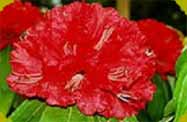|
Costus speciosus
(Koen) Sm.

|
Species |
Costus speciosus
(Koen) Sm. |
|
Local Name |
Beth laure(Nep), Ruyang (Lep) |
|
Synonym |
|
|
Family |
Zingiberaceae |
|
Habitat |
A tuberous erect herb. |
|
Distribution |
Loves to grow in dry land in temperate region. |
|
Sikkim |
Burmeok (East Sikkim), Ranipool-Gangtok, Samdong, Dikchu-
Sankalang, Jorethang Melli, Passingdong- Bay, Prekchu-
Yuksom, Singtam- Rakdong Tintek. |
|
Out side |
West Bengal, Ceylon- Malay Islands, and China. |
|
General |
Pantropics, Eastern Himalaya (East Nepal- Bhutan). |
|
Morphological |
An erect plant 1.2- 2.7 m high;
rootstock tuberous, insipid; stem sub woody at the base.
Leaves 15- 30 by 5.7- 7.5 cm, sub sessile, spirally
arranged, oblong or oblanceolate- oblong, acute or
acuminate, often cuspidate, glabrous above,
silky-pubescent beneath, base rounded; sheaths
coriaceous; ligule- 0. Flowers white, numerous, in very
dense spikes 5- 12.5 by 3.8- 7.5 cm; bracts 2- 3.2 cm
long, ovate, acuminate, often pungently mucronate,
bright red; bracteole solitary below the calyx, 1.6 mm
long. Calyx 3.2 cm long; lobes 6 mm long, deltoid- ovate
cuspidate. Corolla- tube as long as the calyx; lobes
ovate- oblong, apiculate, the lateral lobes 3.5 by 1.3
cm. the dorsal 4 by 2 cm. Lip suborbicular, white with a
yellow centre, 5 cm and more in diameter, concave,
plicate, crisped, the margins sometimes meeting in the
middle; disc pubescent and with a tuft of hairs at its
base. Stamen 3.8- 4.5 cm long, with a tuft of hairs at
the base of the filament; connective petaloid, 13 mm
broad, pubescent,
produced into a glabrous appendage as long as the linear
anther- cell. Style 3.8 cm long, slender; stigma with a
semi lunar ciliate mouth. Capsules globosely 3- gonous,
2 cm diameter, red. Seed black, with a white aril.
|
|
Flowering |
July-October |
|
Fruiting |
October -December |
|
History |
|
|
Parts |
Rhizome. |
|
Status |
Vulnerable |
|
Phytochemistry |
Two new quinones-
dihydrophytylplasto-2-uinone and its 6- methyl
derivative- along with a tocopherolquinone and 5α-
stigmast- 9 (11) en- 3β- ol isolated from seeds and
their structures elucidated (Phytochemistry 1984, 23,
1725); methyl hexadecnoate, methyl octadecanoate and
tetracosanyl octadecanoate isolated from seeds (Indian
J.Pharm. Sci. 1984, 46, 150); a tocopherol isolated from
seeds and identified as G2- tocopherol; five new
compounds- tetradecyl13-
methylpentadecanoate,tetradecyl11-
methyltridecanoate,14- oxotricosanoid- acid,14-
oxoheptacosanoid acid and 15 oxoctacosanoid acid-
isolated from rhizomes and characterized (Phytochemistry
1986, 25, 1899); seed oil (6.0%) consisted of palmitic
(55.97), oleic (23.75%), linoleic, stearic, myristic and
lauric acids. Defatted seeds contained diosgenin,
glucose, galactose and rhamnose (Indian For. 1986, 112,
135; Chem.Abstr. 1987, 106, 99407e);
31- norcyicoartanone, cycloartanol, cycloartenol and
cyclolaudenol isolated from roots (Planta Med. 1988, 54,
268); methyl 3- ( 4- hydroxyphenyl ) -2E propanoate
isolated from rhizomes (Planta Med. 1988, 54, 477). |
|
Agrocultivation |
|
|
Reference |
1. Anonymous (1992). The Useful
Plants of India. Publications and Information
Directorate, CSIR. New Delhi. 143.
2. Kiritikar, K.R & B.D. Basu (1994).
Indian Medicinal Plants (Vol. 4). Bishen Singh Mahendra
Pal Singh, Dehradun, 2440- 2442.
3. Progress Report of the Project
"Studies on Medicinal Plants of Sikkim" (1998- 2001).
State Council of Science and Technology for Sikkim.
4. Rai, Lalit Kumar & Eklabya Sharma (1994). Medicinal
Plants of the Sikkim Himalayas. Bishen Singh Mahendra
Pal Singh, Dehradun, 35. |
|
Medicinal |
|
|
Ayurvedic |
The root is pungent, bitter; useful in bronchitis,
fever, "Kapha" and "Vata". Dyspepsia, inflammation,
anemia, rheumatism, lumbago, hiccough. |
|
Unani |
|
|
Traditional |
Rhizome mixed with sugar is used in venereal diseases.
|
|
Others |
The underground tubers are now considered as a source of
Diosgenin, the precursor of steroids, including sex
hormones and oral contraceptives. Also, a tonic and
anthelmintic may be obtained from it. The extract from
the tubers and stem is given orally (usually at morning
time, empty stomach) to cure the urinary tract
infections and inflammation. In the united provinces,
from the root a strengthening tonic is made, and it is
also used as an anthelmintic. In Bengal and in the
Konkan, the root is considered depurative and
aphrodisiac. |
|
Prepartation |
|
|
Picture |
|
|
|
|
|

Rhododendron


Amongst the many
floral treaties of Sikkim Himalaya one of the earliest ones may be
found over the genus Rhododendron (Gk. rhodo = red, dendrons = tree
). |
| |
|
|
|

Orchid


Orchid
known for their brilliance in colors, unusual shapes
attractive growth habits, variety in fragrance and
exquisite beauty can attract any nature lovers.
|
| |
|
|
|

Medicinal Plant


Sikkim
with its total geographical area of 7,096 sq km is
bestowed with a huge diversity of flora and fauna.
|
| |
|
|
|
|
|